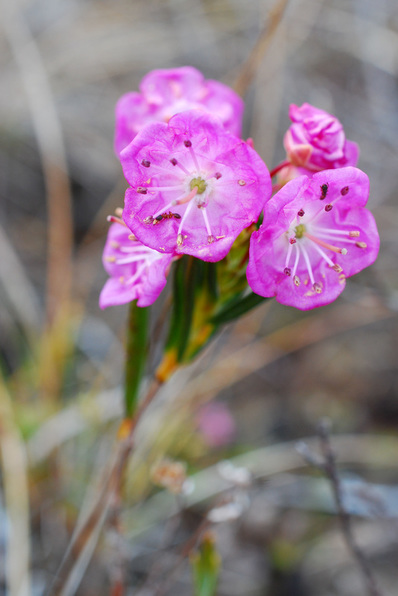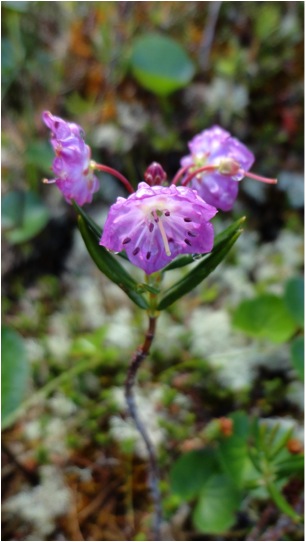Western bog-laurel, swamp-laurel, alpine laurel •
Kalmia microphylla ssp. occidentalis
Identification
When in flower in the spring and summer western bog-laurel is easily identified by its pink saucer-shaped flowers. It grows up to 50 cm tall and has dark green leaves which are leathery on top and whitish and fine-hairy underneath. Western bog-laurel produces small red fruits, which should never be eaten.
Habitat & Range
The plant is found in peat bogs and wet meadows at all elevations. The western bog-laurel is restricted to the western side of North America, reaching as far south as California, north to Alaska, and east to the Northwest Territories, northwestern Manitoba, and Colorado.
Similar Species
Like bog-rosemary (Andromeda polifolia), western bog-laurel is poisonous. Both contain the compound andromedotoxin, which causes breathing problems, dizziness, cramps and diarrhea, and lowers blood pressure.
Care must be taken not to confuse these species with Labrador tea (Rhododendron groenlandicum), which is commonly used to make tea. Labrador tea has rusty brown hairs on the undersides of leaves, as opposed to the white hairs of Western bog-laurel and the hairless leaves of bog-rosemary.
Human Uses
Although poisonous, western bog-laurel was used as a wash for skin ailments by the Tlingit, was boiled by the Kwakwaka'wakw to be drunk or used on open sores, and used by the Haida with various other plants to make a medicinal drink.
When in flower in the spring and summer western bog-laurel is easily identified by its pink saucer-shaped flowers. It grows up to 50 cm tall and has dark green leaves which are leathery on top and whitish and fine-hairy underneath. Western bog-laurel produces small red fruits, which should never be eaten.
Habitat & Range
The plant is found in peat bogs and wet meadows at all elevations. The western bog-laurel is restricted to the western side of North America, reaching as far south as California, north to Alaska, and east to the Northwest Territories, northwestern Manitoba, and Colorado.
Similar Species
Like bog-rosemary (Andromeda polifolia), western bog-laurel is poisonous. Both contain the compound andromedotoxin, which causes breathing problems, dizziness, cramps and diarrhea, and lowers blood pressure.
Care must be taken not to confuse these species with Labrador tea (Rhododendron groenlandicum), which is commonly used to make tea. Labrador tea has rusty brown hairs on the undersides of leaves, as opposed to the white hairs of Western bog-laurel and the hairless leaves of bog-rosemary.
Human Uses
Although poisonous, western bog-laurel was used as a wash for skin ailments by the Tlingit, was boiled by the Kwakwaka'wakw to be drunk or used on open sores, and used by the Haida with various other plants to make a medicinal drink.
References
Kalmia microphylla (Hook.) A. Heller alpine laurel; swamp laurel; western bog-laurel. In Klinkenberg, Brian. (Ed.). E-Flora BC: Electronic Atlas of the Plants of British Columbia [eflora.bc.ca]. Lab for Advanced Spatial Analysis, Department of Geography, University of British Columbia, Vancouver. Accessed on 01/28/13.
Pojar, J. and MacKinnon, A. (2005). Plants of Coastal British Columbia, Revised. Vancouver, BC: Lone Pine Publishing. P. 65.
Authors and editors of page
Chanda Brietzke and Brian Starzomski (2013).
Kalmia microphylla (Hook.) A. Heller alpine laurel; swamp laurel; western bog-laurel. In Klinkenberg, Brian. (Ed.). E-Flora BC: Electronic Atlas of the Plants of British Columbia [eflora.bc.ca]. Lab for Advanced Spatial Analysis, Department of Geography, University of British Columbia, Vancouver. Accessed on 01/28/13.
Pojar, J. and MacKinnon, A. (2005). Plants of Coastal British Columbia, Revised. Vancouver, BC: Lone Pine Publishing. P. 65.
Authors and editors of page
Chanda Brietzke and Brian Starzomski (2013).







